The History Of Rover 75

The Rover 75 (codenamed R40 during development) is an executive car produced initially by the Rover Group at Cowley, Oxfordshire, UK, and later by MG Rover at their Longbridge site in Birmingham, UK. The Rover 75 was available with either a saloon or estate body and, latterly, with front-wheel drive or, in V8-engined form, with rear-wheel drive.
The Rover 75 was unveiled at the 1998 Birmingham Motor Show — at the same time as the new Jaguar S-Type which had similarly 'retro' styling. Deliveries commenced in February 1999 from Rover's Cowley production facility.
Production of the Rover and MG branded models ceased in 2005 when manufacturer MG Rover entered administration. However, 'new' models with delivery mileage are still being registered. The Chinese manufacturer SAIC has started production of their version of the 75, called the Roewe 750, which is a slightly stretched version of the standard R40 design developed from designs purchased from MG Rover Group in 2004. Rival Chinese manufacturer Nanjing Automobile Group (the owner of the MG brand and MGR tooling) has started production of the MG 7. The latter vehicle cannot be branded as a Rover because NAC-MG do not own the rights to the brand, which Ford purchased in 2006. This version is essentially the same as the last models built in Britain by MG Rover Group.
Both the MG 7 and Roewe 750 have started production in China.
The Rover 75 started life as a project for the complete re-skin of the Rover 600, under the control of Rover Group designer Richard Woolley, but following the BMW takeover it was quickly decided that the Rover 600 would not be re-skinned but replaced by an entirely new model. Work on the new model, codenamed 'R40' progressed well with little operational interference from BMW, with the basic design having received an enthusiastic response from BMW management and both BMW and Rover believing that a retro design would be the ideal choice for Rover. At the same time it offered a distinct marketing separation from the E46 BMW 3 Series in the executive segment.
Under the skin, there was a first attempt at considerable component and concept sharing with BMW to replace the input of the previous partner Honda. To replace the previously employed Perkins-developed engines that were efficient, but noisey, BMW provided its own common rail motor (known in the Rover 75 as the M47R). This diesel engine was a mildly de-tuned BMW 2.0 litre turbodiesel, the same core engine being used at the same time in the 3 & 5-Series, and the Land-Rover Freelander.
Petrol engines provided were Rovers own K series in 4 cylinder form, of 1.8 litre displacement, with DOHC 16 valve form with Rover/ Motorola MEMS engine management. The quad cam KV6 was provided in 2.0 and 2.5 litre displacement with 24 valves and Siemens engine management. The 2.0 litre was dropped on introduction of the 1.8 litre turbo as these were more favourable to the UK company fleet market (company cars are taxed by the UK Government according to carbon dioxide emissions). Gear boxes on all manual cars were Getrag 5 speed fed via a hydraulic clutch, and automatic cars were fitted with a 5 speed Jatco unit.
Press speculation at the launch that the 75 was based on the BMW 5 Series thanks to its large size and especially the central tunnel in the chassis (normally only found on rear wheel drive cars) and the BMW Z-Link suspension from the rear wheel drive BMW 3-Series, was misinformed. The central tunnel was built into the chassis to increase structural rigidity, using a BMW-developed floorpan concept that had explored front wheel drive but which had been rejected and remains unused by the BMW brand up to the present day. As the 75 took shape, this core engineering was passed over to Rover and evolved into the Rover 75 structure. The tunnel concept with a front wheel drive chassis & Z-axle was subsequently also used by BMW for its new Mini, and remains in production, due to its extreme stiffness and resultant excellent chassis control.
The car quickly attracted praise for its characteristics, including its ride quality, interior, and traditional looks. Critics of the car labelled its styling too "retro", suggesting it had been designed with an older buyer in mind, was not sporting enough when compared to the competition. However, the 75 won a series of international awards including various "most beautiful car" awards, including one in Italy.
Assembly originally took place at Cowley, but in 2000, following the break up of the Rover Group and the split with BMW, production was moved to Longbridge. 2001 saw the introduction of the Rover 75 Tourer (developed alongside the saloon but never authorised for production by BMW), swiftly followed by the MG ZT and MG ZT-T, more sporting interpretations of the model, differentiated by modified, sporting chassis settings and colour and trim derivatives. Between 2000 and 2003, there were few changes to the range, the biggest being the 2.5 litre V6 engine being joined by a low pressure turbocharged 1.8 litre, 4-cylinder engine. The introduction of the 'greener' 1.8 litre turbo greatly benefited British company car drivers who are taxed on carbon dioxide emissions. A customisation programme, Monogram, was launched, allowing buyers to order their car in a wider range of exterior paint colours and finishes, different interior trims and with optional extras installed during production.
In early 2004, Rover face-lifted the design of the 75 to a less retro, more European, look - all of the modifications were in the bolt on components with the body structure remaining unchanged. Rover also added a new trim to the range called Contemporary which featured a more modern dashboard trim and exterior. This design was given a mixed reception by the motoring press, and Rover announced the new V8 model with a completely different front grille only a few months later. This grille was said to be inspired by the Rover V8s of the past but caused some controversy, being similar to the then new style of larger Audis. A long wheelbase 'limousine' version called Rover 75 Vanden Plas – about a foot longer than the regular 75 – also adopted this new grille. The Rover V8 grille was made available as an option for the rest of the range shortly afterwards.
The Rover 75 V8 was created as means of proving MG Rovers engineering expertise and to attract a development partner to the company. The car was extensively re-engineered to accommodate a 4.6 litre V8 unit (obtained from Ford and used in the Mustang), driving the rear wheels to give a car with much higher performance, taking advantage of the stiffening tunnel in the body structure. These cars were built on the standard production line, and then removed to allow the necessary structural modifications to be carried out. The cars were then returned to the trimming lines for completion. Just under 900 were produced in both saloon and Tourer (estate or wagon) carrying either Rover 75 or MG ZT trim. The cars had numerous differences to the standard versions, drive train not withstanding, with non standard heating/ ventilation, and brakes and suspension capable of dealing with the extra power. Externally, there is little to indicate what is under the bonnet, other than quad exhaust pipes and a couple of subtle badges, although a large 'V8 grille' was fitted to some cars following the 2004 facelift. They are likely to become sought after as classics. A heavily modified MG ZT-T V8, known as the X-15 broke the speed record for a non-production estate car on Bonneville Salt Flats in September 2003, achieving 225.609mph (363.082km/ h). The engine was bored out to 6 litre producing 765bhp (570kW; 776PS), but remained normally aspirated.[citation needed]
Since its launch, the 75 has been one of the most popular ministerial cars in the British Government. Various Ministers are driven around in 75s and Tony Blair had access to a 75 Limousine while he was in power, but was never seen in it.. Recently though[when?], Alistair Darling has been seen in a 'V8 Grille' Rover 75 which could be the 75 Limousine. MPs said to have or have had a 75 include:[citation needed]
- Patricia Hewitt
- Gordon Brown
- John Reid
- Charles Kennedy
- Ruth Kelly
- Tessa Jowell
- Richard Burden
- What Car? ‘Car of the Year’ 1999.
- What Car? ‘Compact Executive Car of the Year’ 1999
- What Car? ‘Diesel Car of the Year’ 1999
- Auto Express ‘World Car’ 1999
- The Journal / AA ‘Business Car of the Year’ 1999
- Italian ‘World's Most Beautiful High Class Saloon’ 1999
- Bild am Sonntag ‘Golden Steering Wheel Award’ 1999
- The Society of Plastic Engineers ‘Innovative use of plastic’ for the 75's V6 plastic intake system 1999
- British International Motor Show ‘Best riding and handling front wheel drive saloon in the world’ 1999
- Japanese 'Import Car of the Year' 1999
- Middle East Wheels & Gears ‘Car of the Year’ 1999/ 2000
- Japanese 'Import Car of the Year' 2000
- New Zealand's National Business Review 'Car of the Year' 2000
- Executive Class ‘Portuguese Car of the Year’ 2000
- What Car? ‘Compact Executive Car of the Year’ 2000
- The only executive car to be short-listed in the 2000 ‘European Car of the Year Awards’
- Used Car Buyer 'Used Car of the Year’ 2000
- Used Car Buyer ‘Used Car of the Year’ 2001
- Diesel Car Magazine ‘Compact Executive Car’ 2001
- JD Power customer satisfaction survey ‘Only European car in the Top 5’ 2001
- Auto Express Used Car Honours 'Best Diesel Car' 2002
- Used Car Buyer 'Best Used Medium Car’ 2002
- ITM ‘Car of the Year' 2002
- Australian Institute of Transport Management ‘Car of the Year’ 2002
- Used Car Buyer ‘Used Car of the Year’ 2004
- Used Car Buyer ‘Best Used Family Car of the Year’ 2004
- ‘Most popular British Forces Germany tax free car purchase’ 2004
- Auto Express Drive Power ‘Best Ride Quality’ 2006
- Auto Trader Used Car Awards 'Best Family Car' 2007
The Rover 75 and MG ZT are currently out of production because MG Rover Group went into administration in April 2005. Specifications for the Rover 75 design were purchased by Shanghai Automotive Industry Corporation (SAIC) in early 2005, although the new MG Rover Group owner, Nanjing Automobile (Group) Corporation (NAC) now owns the tooling for the car. It was thought unlikely that a dispute would arise since both companies are owned by the Chinese state, however SAIC have since started production of their version of the Rover 75, while NAC are continuing to press forward with production of their version, the MG 7Z.
In January 2006, Automotive News reported that both Nanjing and SAIC would make the 75 saloon. Nanjing says it will produce the 75 as the MG 7, and the 75 Tourer as the MG 7T, from 2007. Both companies are co-operating each other about the car's parts and components.
In August 2006, the first images and details of SAIC's version of the Rover 75 appeared. Originally, this was to be called the Lu-sheng 75. Following the purchase of the Rover brand by Ford, a new name of Roewe has been created for use worldwide. The brand and Roewe 750 were launched at the 2006 Beijing Motor Show, which took place in November. The model is based on the long-wheelbase 75 platform and engineering was completed by Ricardo 2010.
Initial sales of the Rover 75 were disappointing, as it failed to match the BMW 3 Series and Audi A4 in the British car sales charts during 1999. The public unveiling of the car at the Birmingham Motor Show was unfortunately over-shadowed by a speech containing criticism of the British Government's attitude to financial assistance in the redevelopment of the Rover Longbridge factory (where the new Mini was to have been produced). Stunned press reaction interpreted this as saying that BMW were unhappy with continuing financial losses and were intending to close Rover down. This undoubtedly scared off many prospective buyers, despite the very positive reaction to the car itself. Indeed it did (and still does) hold up very well with the Jaguar S-Type that was unveiled at the same show.
But sales picked up substantially during 2000, thanks largest to it being Britain's fifth most popular new car of the month in April of that year. It was still selling reasonably well at the time of MG Rover's bankruptcy in April 2005, and a small number of unsold 75s were still in stock as of early 2007, as Nanjing Automobile was preparing to re-open Longbridge.
1999-2004
- Classic
- Classic SE
- Club
- Club SE
- Connoisseur
- Connoisseur SE
- Vanden Plas (long wheel base model)
2004-05 (facelift)
- Classic
- Connoisseur
- Connoisseur SE
- Contemporary
- Contemporary SE
- Limousine (replaced Vanden Plas as name for LWB model)
2006 SAIC Roewe 750
- 1.8 Turbo base (18K4G, essentially a Rover K-series)
- 1.8 Turbo high-line (18K4G)
- 2.5 base (25K4F, essentially a detuned Rover KV6)
- 2.5 high-line (25K4F, essentially the Rover KV6)
From Wikipedia, the free encyclopedia
More About Rover 75
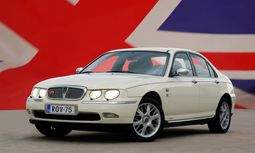
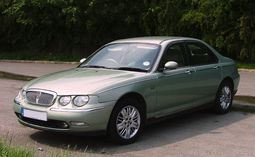
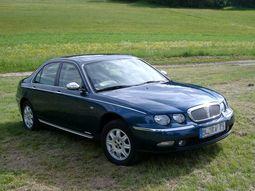
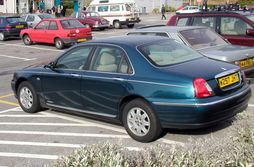
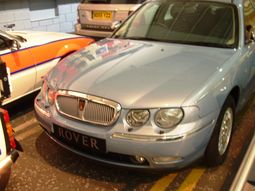
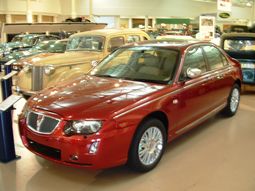
|